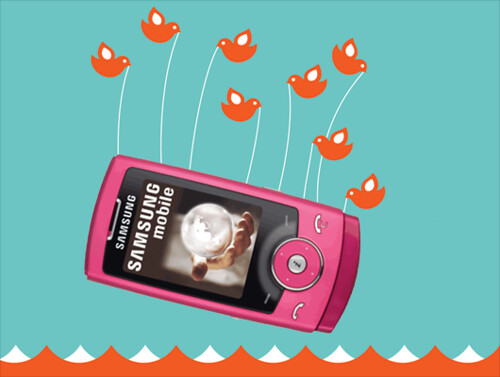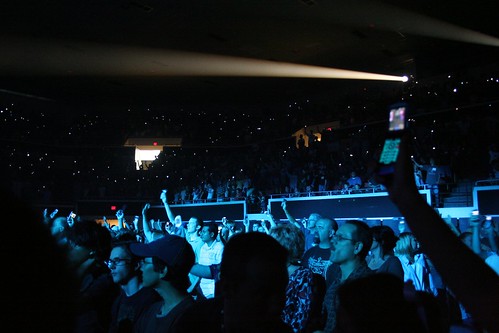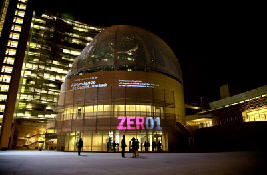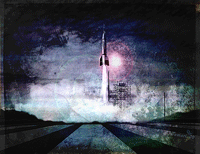
- Midnight Launch by Temari 09 (from flickr)
For arts organizations, February brings with it the final throes of determining next year’s season. Some have renewals out already; others are still mired in scuffles with artistic, production or finance offices over which productions and dates will make next season the best it can be. Regardless of where you are in the process, if you are in marketing or PR, your thoughts have probably turned to how you will get the word out about the new season. You may have perfected publicizing your season through renewal mailings and paper season brochures, but how do you “shout your season from the rooftops” online?
Kim Witman, director Wolf Trap Opera Company (WTOC), has embarked upon an innovative new campaign to launch the company’s season this year. Located just outside of Washington, D.C., Wolf Trap bills itself as the "future of opera", a slogan that the organization seems to have taken to heart both in its programming and in its marketing efforts. As a researcher of how non-profit arts orgs use technology, I have been continually impressed by Wolf Trap’s leadership in online social media, particularly in their creation of a ning (a customized social networking site)—one of the first performing arts orgs to do so.
This season, Kim aims to get the word out to existing fans and potential audience members with a "digital season launch", combining elements of technology, grassroots campaigns, and social networking. She will celebrate today’s announcement of the WTOC 2010 season by doing guest blog posts and interviews in a few places across the blogosphere (see a complete listing at the WTOC blog).
I caught up with Kim about a week ago--a busy week for her, as she was returning from the classical Grammys. Wolf Trap was nominated for Best Opera Recording for their 2009 recording of John Musto’s Volpone. As she prepared to launch the season today, February 9, she took the time to answer some questions about launching a season digitally.
Q. In previous blog entries on Technology in the Arts, we’ve talked about digital season brochures (such as the London Symphony Orchestra) and other ways to publicize your season using technology platforms. What exactly is Wolf Trap’s concept of a digital season launch?
Kim: Wolf Trap Opera’s season announcement is only a small part of a large kick-off for the entire 2010 season of the Wolf Trap Foundation for the Performing Arts, and within that context we don’t have the chance to provide a whole lot of detail and texture for the opera performances. My guest posts and interviews on colleagues’ blog sites give me a chance to tell many sides of our story while creating a bit of a buzz on our little corner of the web.
Q. So today is the big day of your season launch online. What is rolling out today and what are you doing today to “shout your season from the rooftops”?
Kim: The WTOC blog is a spot from which readers and fans can fan out to dig deeper into the parts of our season and the aspects of our company that are of particular interest to them. In addition to linking to posts on the other blogs participating in today’s effort, we’ve cranked out the news via our Facebook fan page (become a fan!), our Twitter feeds (www.twitter.com/WolfTrapOpera and www.twitter.com/kimpwitman) and the WTOC Hotspot. Phew.
Q. You drew inspiration for this campaign from marketing guru Seth Godin, who is publicizing his latest book not through newspapers, TV or any so-called “traditional” means, but instead through blogs and other online outlets. How did you modify this idea to fit Wolf Trap Opera Company’s specific needs for the digital season launch concept?
Kim: I kept the guts of Seth’s approach intact. (I wrote him before embarking on this project, in the spirit of imitation being the sincerest form of flattery. He wished me luck.) I contacted the writers of a few blogs that I read regularly, and I offered to write guest posts or engage in interviews that target the area(s) of interest between my readership and theirs. My effort isn’t nearly as massive as Seth’s was, but the goal is to focus a critical mass of attention on WTOC for a day!
Q. I have heard of surprisingly few arts organizations engaging in a digital season launch. Which aspects of your organization and its marketing channels made a digital season launch a good idea? Do you think this sort of effort will become commonplace in the future?
Kim: Our small company doesn’t typically have a lot of traction with traditional media anyway, so this isn’t a huge shift. For the last 10 years, our main vehicle has been the website, along with the two direct mail pieces that go out later in the spring (calendar with entire Wolf Trap season, and WTOC brochure mailed to a smaller target audience). We will continue with those traditional efforts.
The nerve center of this season announcement is the WTOC blog and its readership. The daily interchange between bloggers and their readers is vital, interactive, dynamic, messy and wonderful – and that’s the kind of energy we need to tap into. Clearly, I could’ve compiled all of the guest posts and Q&A’s and put them on a web page, but there would be something too clinical and linear about that.
These types of initiatives are becoming more common, and the trend will undoubtedly continue. Digital media make it possible to tell your story, no matter your budget. The challenge is to do it wisely and in a targeted fashion. All of the social networking initiatives are tremendously time-intensive, and they can rob a small organization of its precious human resources. We’ve chosen to ride this wave, but we’re constantly weighing its assets and liabilities.
Q. You mentioned the time-intensive nature of investing in social media and also touched on how different platforms serve your followers differently. WTOC currently has a blog, ning site, and Twitter, Facebook, and YouTube accounts. How do you manage which content goes on which site?
Kim: It’s an ever-moving target, but this is how we’ve been focusing our various initiatives:
- Facebook: By becoming a fan, you can get our updates (including my blog posts) through your Facebook feed. We look at this site as a way to deliver WTOC highlights to FB users without them having to go to a separate site.
- Hotspot (ning platform): The content is pretty much a clone of Facebook, with the added attraction of a comprehensive calendar. It exists primarily to inform fans and patrons of our non-ticketed events (artist panel discussions, free concerts, etc) and to provide one-click clearinghouse for non-Facebook-users.
- The WTOC Blog gives us a distinctive and informal voice. It allows me to speak in detail (and when appropriate, in industry jargon) to aspiring singers and other opera geeks. And it allows me to speak more frankly and conversationally than a traditional web page. (I love that the words “traditional” and “web page” can now exist next to one another!)
- Twitter still serves a niche audience. Although (when we’re not in season), both of our Twitter accounts often run the same updates, they are differentiated in the summer. I view mine as a conversation between me and my arts industry colleagues. And the WTOC twitter feed is intended to allow us to communicate with fans and patrons.
- The YouTube account isn’t terribly active because we are still struggling with artist rights and releases in order to be able to post content, and because we don’t have media staff in house to spend the time needed to do the pre-production work on video clips.
Q. How are you spotlighting the Season Launch through these networks?
Kim: We’ll simply be putting the WTOC blog link front and center, encouraging folks to link through and start exploring!
Q. Anything else you would like to tell us in closing?
Kim: My son is a software programmer, and I get most of my geek fix through him. He is quick to remind me that all of our technological tools are not effective until they disappear into the fabric of the task at hand. It takes some energy to ride the wave of the technological flavor of the day, but our goal is to conquer the learning curve and allow the technology not to be an end in itself, but a tool through which our real message is conveyed.
Kim Witman of the Wolf Trap Opera Company is celebrating today’s announcement of the WTOC 2010 season by doing guest blog posts and interviews in a few places across the blogosphere.
Link back to Kim’s blog entry at www.wolftrapopera.blogspot.com for a complete list – all of the links should be active by midday on Tuesday, February 9.
 Kim Witman assumed directorship of the Wolf Trap Opera Company in 1997 after having served the Company since 1985 in a variety of roles: principal coach, assistant conductor, music administrator and chief of music staff. A graduate of The Catholic University of America (M.M.) and Elizabethtown College (B.S. Music Therapy), she has also been a visiting faculty member in the opera departments of the Peabody Conservatory of Music and the University of Maryland. In addition, she has been music administrator, chorusmaster and assistant conductor for The Washington Opera, adjudicator for the Metropolitan Opera National Council Auditions and assistant conductor for Washington Concert Opera. Ms. Witman has been active as an opera coach and recitalist in the Washington, D.C. area since 1981. She has performed at the Kennedy Center, the Philips Collection, the White House, and at New York’s Merkin Hall. Committed to de-mystifying the opera business for fans and aspiring professional singers, she writes at www.wolftrapopera.blogspot.com.
Kim Witman assumed directorship of the Wolf Trap Opera Company in 1997 after having served the Company since 1985 in a variety of roles: principal coach, assistant conductor, music administrator and chief of music staff. A graduate of The Catholic University of America (M.M.) and Elizabethtown College (B.S. Music Therapy), she has also been a visiting faculty member in the opera departments of the Peabody Conservatory of Music and the University of Maryland. In addition, she has been music administrator, chorusmaster and assistant conductor for The Washington Opera, adjudicator for the Metropolitan Opera National Council Auditions and assistant conductor for Washington Concert Opera. Ms. Witman has been active as an opera coach and recitalist in the Washington, D.C. area since 1981. She has performed at the Kennedy Center, the Philips Collection, the White House, and at New York’s Merkin Hall. Committed to de-mystifying the opera business for fans and aspiring professional singers, she writes at www.wolftrapopera.blogspot.com.





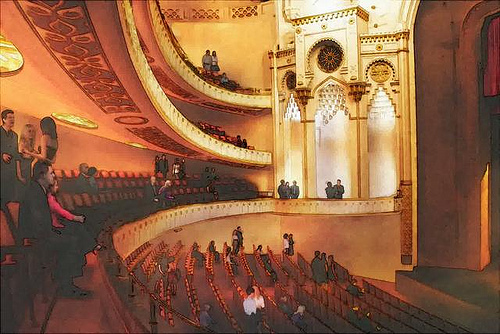
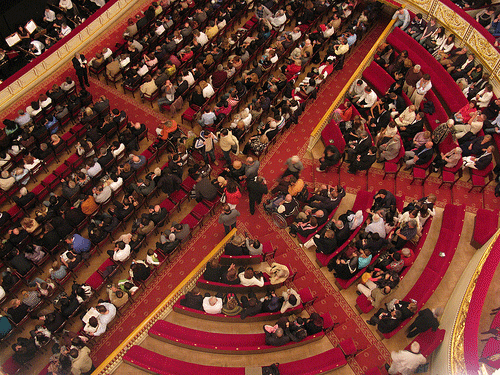

 Kim Witman assumed directorship of the Wolf Trap Opera Company in 1997 after having served the Company since 1985 in a variety of roles: principal coach, assistant conductor, music administrator and chief of music staff. A graduate of The Catholic University of America (M.M.) and Elizabethtown College (B.S. Music Therapy), she has also been a visiting faculty member in the opera departments of the Peabody Conservatory of Music and the University of Maryland. In addition, she has been music administrator, chorusmaster and assistant conductor for The Washington Opera, adjudicator for the Metropolitan Opera National Council Auditions and assistant conductor for Washington Concert Opera. Ms. Witman has been active as an opera coach and recitalist in the Washington, D.C. area since 1981. She has performed at the Kennedy Center, the Philips Collection, the White House, and at New York’s Merkin Hall. Committed to de-mystifying the opera business for fans and aspiring professional singers, she writes at
Kim Witman assumed directorship of the Wolf Trap Opera Company in 1997 after having served the Company since 1985 in a variety of roles: principal coach, assistant conductor, music administrator and chief of music staff. A graduate of The Catholic University of America (M.M.) and Elizabethtown College (B.S. Music Therapy), she has also been a visiting faculty member in the opera departments of the Peabody Conservatory of Music and the University of Maryland. In addition, she has been music administrator, chorusmaster and assistant conductor for The Washington Opera, adjudicator for the Metropolitan Opera National Council Auditions and assistant conductor for Washington Concert Opera. Ms. Witman has been active as an opera coach and recitalist in the Washington, D.C. area since 1981. She has performed at the Kennedy Center, the Philips Collection, the White House, and at New York’s Merkin Hall. Committed to de-mystifying the opera business for fans and aspiring professional singers, she writes at 




